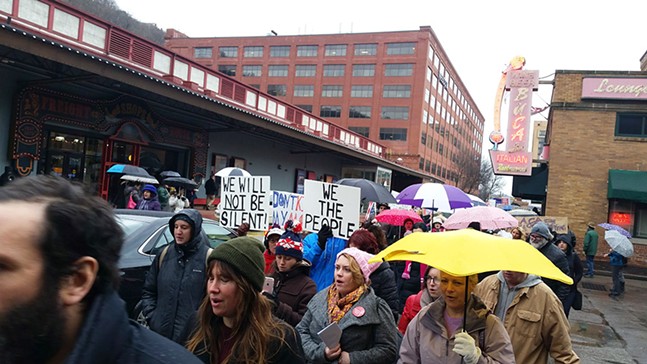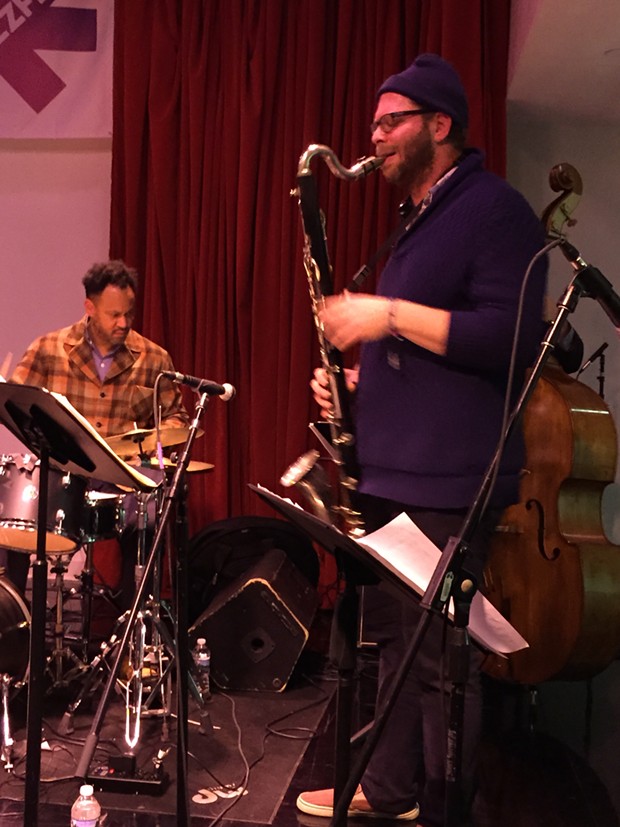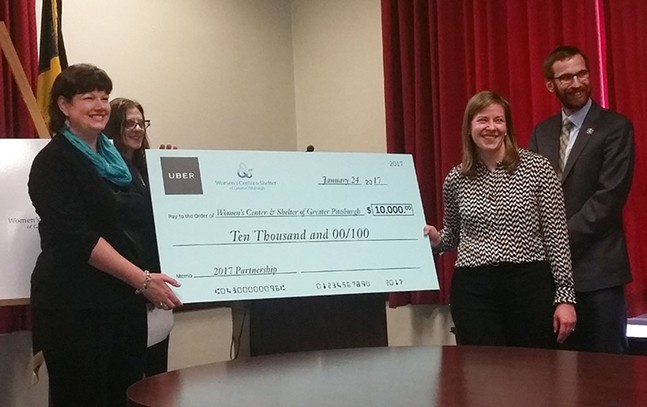Tuesday, January 31, 2017
A few weeks ago, Pittsburgh joined in on the effort dubbed Tuesdays with Toomey. The first week, approximately 40 protesters went to Toomey's local office in Station Square. Last week, the number of protesters rose to more than 200, according to organizers.
But this week, the Pittsburgh organizers received an email saying that Toomey staffers wouldn't be able to meet with them. And whether it was due to the staff's refusal or the controversial executive orders signed by President Donald Trump last week, earlier today, an estimated 250 protesters showed up at the senator's local office.
"Things are happening so fast in Washington," said Jennifer McDowell, co-chair of the local Tuesdays with Toomey. "It feel like every 15 minutes something happens that we have to stand against."
On Friday, Trump signed an executive order barring foreigners from several majority-Muslim nations from entering the United States, a move that has generated serious backlash domestically and abroad. But yesterday, Toomey released a statement supporting the executive order.
“I support the administration's decision to increase vetting and temporarily suspend the admission of certain individuals from states that sponsor or provide safe havens to terrorists, or are too weak to prosecute terrorists within their borders. Terrorists have successfully infiltrated refugee populations entering Europe and gone on to commit heinous acts of barbarity. I have long been concerned about our ability to distinguish between predominantly peaceful and innocent refugees, and the likely rare, but lethal, terrorists in the midst of those refugees coming from terror havens and lawless lands. That is why I, along with a bipartisan majority of the House and Senate, supported the SAFE Act, which called for enhanced vetting," Toomey said in a statement.
Many of the people who turned out today opposed Toomey's support for the executive order with signs and chants saying "refugees are welcome here." Other protesters marched to protect women's reproductive rights and to ask Toomey not to dismantle the Affordable Care Act and the expansion of Medicaid passed under President Barack Obama's administration.
"The people we serve, they depend on the Affordable Care Act. They depend on Medicaid expansion," said Kim Evert, CEO of Planned Parenthood of Western Pennsylvania. "If you take away the Affordable Care Act, if you take away Medicaid expansion, it hurts women's health".
Hundreds marched past Toomey's office and stopped at the Smithfield Street Bridge, where they invited participants to share their health-care stories.
One woman said she's had cancer four times in the past 11 years. Another man told the crowd the story of his mother, who he says died because she couldn't get health insurance. And a woman said that a family member couldn't receive a life-saving transplant until the doctor was told whether the person could afford post-op medications; the only way her family member could pay for these medications, the march participant said, was through Medicaid.
"I felt like the only power I had available is to put my body in the street," said another protester, Jennifer Lawton.
In addition to the street protests, thousands have been flooding Toomey's offices with calls and, when those calls weren't answered, they turned to the fax machine. According to a list compiled by the website Fax Zero, which lets people send faxes for free, in the past 24 hours, Toomey has received more faxes from users than any other representative, clocking in at 1,660.
"Toomey needs to understand that he works for all of us," said Melissa Harkes. "I'm hoping other people see us protesting and making a difference."
Tags: Donald Trump , Pat Toomey , Muslim ban , Affordable Care Act , Obamacare , PolitiCrap , Image
“6 Days. Over 150 Jazz Groups. 600+ Musicians,” declares the program for the 13th Annual NYC Winter Jazzfest, which took place in New York City Jan. 5-10.
And yet some knuckleheads feel the need to ponder whether or not jazz is dead. After a weekend traipsing around Manhattan, my feet might not be alive and well, but the music is.
This year, music wasn’t the only thing served up in the festival. Issues of racial and social justice threaded through the performances, from specific pieces that addressed them to a panel discussion titled “Social Justice and the Role of Music,” which featured musicians and representatives from the American Civil Liberties Union and Black Lives Matter. Between sets at virtually every performance space, slides of festival performers were projected onstage, with quotes from each musician expressing solidarity. The boldest examples of jazz have always held these issues at arm’s length, which makes perfect sense since the music is built on the concept of group interaction and discussed with terms like “communication,” “expression” and “freedom."
While the weekend included myriad sets at a number of performance spaces, Thursday night featured just a couple of kick-off events. That means everyone clamored to get into (Le) Poisson Rouge to see veteran saxophonist Pharoah Sanders, leaving yours truly out in the cold. Tickets to the Jazz Concert for Disability Pride proved a little too costly, but The Stone offered a cheaper alternative (albeit one not affiliated with the festival). Situated on the Lower East Side, and virtually nothing more than a room with folding chairs and good acoustics, the John Zorn-directed Stone featured a week-long residency by drummer Jerry Granelli. Celebrating “76 years on the planet and 60 years of performance of improvised music,” Granelli lead a quartet with Jane Ira Bloom (soprano saxophone), Dave Douglas (trumpet) and Mark Dresser (bass) through a rambunctious set of originals and a spritely Ornette Coleman cover. For all his 76 years, Granelli played with the fury and enthusiasm of someone a third his age. “You’re a brave man,” Bloom told me, as I took one of the few remaining seats at the 9 p.m. show, adjacent to a music stand used by Douglas, who stood less than five feet from me during the hour-long performance.
Friday evening, with the Jazz Connect Conference wrapped up, it was time to secure the all-access wristband at the New School Tishman Auditorium, at Fifth Avenue and 13th Street; several of the performances took place within a two-block radius. In the building’s auditorium, the final moments of Craig Harris’ ensemble Breathe started the weekend off on a high note. Or notes, actually. There’s nothing as joyous as the sound of a 40-piece ensemble collectively wailing together over a polyrhythmic groove. Thelonious Monk used to talk about “lifting the bandstand” during a performance. The power of Breathe’s sound could have lifted the whole block.
After that, a two-piece might have seemed anti-climactic. But since half the duo was NYCWJF artist-in-residence Andrew Cyrille, that was not the case. A drummer who seems to be experiencing a career renaissance that eclipses his important tenure with pianist Cecil Taylor in the ’60s, Cyrille paired up with tenor saxophonist Bill McHenry for a sparse but engaging set that included folky melodies (“Drum Song for Leadbelly”), a Monk classic (“Epistrophy”) and a more avant piece (“Drum Man Cyrille”), in which Cyrille’s bass drum sounded like a droning note. Cyrille played three more times with as many groups during the festival, but unfortunately his other sets conflicted with other must-see acts.
Around the corner at the New School’s 12th Street Auditorium, tenor saxophonist Melissa Aldana expanded her usual tenor/bass/drums trio to a sextet, adding piano, vibes and trumpet. The Chilean native, who won the Thelonious Monk International Saxophone Competition in 2013, continues to be one of the instrument’s most impressive soloists. The moods in her set recalled 1960s-era Miles Davis, but everything felt more involved, from the writing to the solos. Aldana and her bandmates had the look of conservatory students (Aldana is 28), but they countered that vision with a full-blown maturity in their playing.
Earlier in the evening, there had been no room in the Glass Box Theater to see trumpeter Jonathan Finlayson, so I wasn’t going to take any chances on missing Mike Reed’s Flesh & Bone, who were set to play in the same intimate space immediately following Aldana. Reed, a drummer from Chicago, who has also done a lot to support original music in that city, brought a sextet that included bass clarinetist (and half-brother of comedian Amy Schumer) Jason Stein and alto saxophonist Greg Ward, both of whom released some of 2016’s best jazz albums under their own names. Reed’s music moves like a modern, turbo-charged version of Charles Mingus. The drummer and bassist Jason Roebke held down the fort, while the horns took off in whatever direction the mood required. Marvin Tate took things even deeper with spoken-word interludes that captured the social-political concerns of the festival. While these kinds of verbal breaks can occasionally bog down such a performance, I found myself wanting to hear more of Tate’s impassioned delivery. When this band releases an album, buy it. Better yet, buy two.
Between the closing roar of Craig Harris’ ensemble and Reed’s unflagging intensity, that might have been enough. But the night was still young. And drummer Jim Black was playing a few flights up from the Glass Box in the obviously named 5th Floor Theater. Last year, he set up shop in the same place with a piano trio. Tonight, pianist Elias Stemeser traded the 88s for an overdriven synthesizer. Chris Tordini moved from upright to bass guitar, and tenor saxophonist Loftur Gudmundsson proved to be a great partner-in-arms to Stemeser. Black, whose newest batch of songs combined anthemic riffs with free blowing, never ceases to astound, always utilizing every part of his drum kit, including the two crash cymbals that look broken or cut in half.
The city supposedly never sleeps, so I saw no reason to either. Onto the M train to the Village — Bleeker Street to be exact — where tenor saxophone quartet Battle Trance was in the middle of an extensive performance at Subculture. Purists might recoil at the sounds these guys create, but for more than half an hour, they roared out ugly overtones, sang through their mouthpieces like choir boys, screeched out harmonics and — when things seems the loosest — magically came together on a low squonk. Don’t miss them when they come to Pittsburgh in the coming months.
Saturday began where Friday night ended for me. Back at Subculture, trumpeter Peter Evans (once a member of the wild and zany quartet Mostly Other People Do the Killing) was finishing up a set marked by extended technique on his horn, filtered through samplers and keyboards by his bandmates.
Pianist Kris Davis followed, performing with three collaborators who appeared on her recent set of duets, Duopoly. While that album had some intriguing moments, seeing the interactions unfold onstage gave it extra life. Billy Drummond joined her for Monk’s “Eronel,” playing so sparsely at first that a patron’s footsteps in Subculture were more audible than him or Davis. Angelica Sanchez joined her next, taking the piano while Davis shifted to electric piano. The two of them carefully divided duties in solos and chord changes, resulting in some delightfully angular poking and pounding. When alto saxophonist Tim Berne had his turn with Davis, her accompaniment in the upper register sounded like shattering glass, and led to a performance with more energy than their studio outing.
The Tishman Auditorium was filled to the rafters with eager listeners ready for various artists on the ECM label, which began in Germany 48 years ago and continues to release a wealth of jazz and classical releases. Saxophonist Ravi Coltrane and pianist David Virelles haven’t released an album for the imprint together, although the latter now has dabbled in his own version of world music on two discs for them so far. Still they made a strong pairing in the auditorium. Playing tenor, soprano and sopranino saxophones, Coltrane often played with a lithe tone that would fit in well on ECM and made a good contrast to Virelles’ heavier attack. The saxophonist never uses his late, iconic father (John Coltrane) to elevate his own status, but he’s also not averse to digging into material from his father’s legacy. His brief version of “Monk’s Mood,” the deep cut Thelonious Monk ballad, went way out of tempo, much like Dad did with the composer at Carnegie Hall in 1957. Later, Coltrane donned his sopranino (a horn rarely heard outside of more avant-garde situations) for a slow, methodical take on “Lush Life,” the ballad Billy Strayhorn wrote while still living in Pittsburgh.
This makes me sound like a real tourist, but I couldn’t help but think that SOB’s takes its name not as an abbreviation of “Sounds of Brazil” but due to the fact that they charge $12 for a mixed drink served in a plastic cup. On the other hand, since no booze was sold at any of the New School venues, and since the roughly 8-ounce drink produced a great buzz, it was worth it. The real reason to travel to SOB’s was Marc Ribot’s Young Philadelphians were putting their harmolodic spin on some classic (albeit slightly cheesy) ’70s R&B hits. Last year, I slightly disparaged the band’s Live in Tokyo disc due to the lackadaisical vocals bringing down an otherwise solid performance by two of the most ingenious guitarists in modern rock or jazz (Ribot, Mary Halvorson) and a funky rhythm section that has close connections to both genuine funk and Ornette Coleman’s harmolodic approach (bassist Jamaaladeen Tacuma, drummer G. Calvin Weston). In person, the vocals were mere trimmings to a wild re-imagining of tunes like “Fly Robin Fly” and “The Hustle.” The quartet definitely elevates them to levels that Silver Convention and Van McCoy never imagined when they first recorded them.
In keeping with the modern twist on things, my Winter JazzFest ended back at the 5th Floor Theater with TALIBAM! HARD VIBE. Drummer Kevin Shea (another member of Mostly Other People Do the Killing, who once lived in Pittsburgh) and keyboardist Matt Mottel have been blowing listeners' ears away with their irreverent, free improvisation in TALIBAM for several years. Adding MOPDtK’s Ron Stabinsky on additional keyboards and Matt Nelson on tenor “a-xophone” (essentially a tenor with electronics attached to it), they band rocked hard on an extended piece. Quite honestly, their set is now a blur not because of the performance but because by that point in the evening, I was spent. Shea slipped me a copy of their upcoming disc on the legendary ESP imprint, which will help me relive the evening though.
The one regret of the trip was missing the Liberation Music Orchestra, which played Tuesday night, two days after I returned home. The late bassist Charlie Haden first launched the ensemble in 1969, playing politically charged music “dedicated to creating a better world … where men of all governments realize the vital importance of life and strive to protect rather than destroy it.” Even with Haden’s passing in 2014, the Orchestra lives on, in this case with the University of Pittsburgh’s Geri Allen leading it. Maybe she’ll bring it to town someday.
Tags: Winter Jazzfest , Pharoah Sanders , Jerry Granelli , Jane Ira Bloom , Jazz Connect Conference , Breathe , Andrew Cyrille , Melissa Aldana , Mike Reed’s Flesh & Bone , Jonathan Finlayson , Jason Stein , Greg Ward , Elias Stemeser , Chris Tordini , Loftur Gudmundsson , Battle Trance , Billy Drummond , Ravi Coltrane , David Virelles , Marc Ribot’s New Young Philadelphians , FFW>> , Image
Monday, January 30, 2017
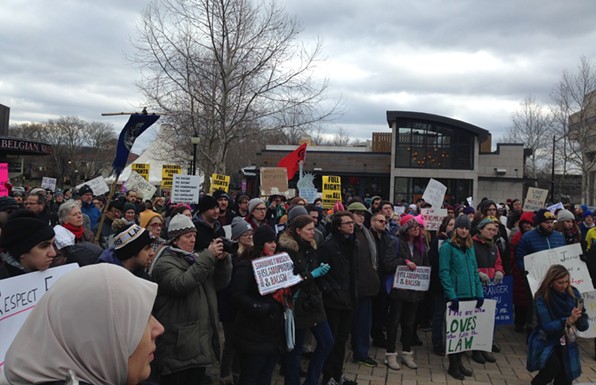
Just three days after Trump signed executive orders to increase immigration enforcement, propose a wall along the U.S.-Mexico border, and reintroduce controversial immigration policies, more than 400 Pittsburghers rallied and marched in Oakland to protests the orders.
A day before the Jan. 28 march, Trump also signed an order banning internationals from mostly Muslim countries from entering the U.S. for 90 days and banning Syrians indefinitely. His order also halted all refugee resettlement to the U.S. for 120 days. Protesters in Oakland decried all of the orders and another 300 some protesters filled the Pittsburgh International Airport on Jan. 29 to continue to decry Trump’s travel ban and refugee stay.
“We might have been born somewhere else, but we are Pittsburgh residents,” said Monica Ruiz of Latino and immigrant-rights group Casa San José at the Oakland rally. “We make Pittsburgh great.”
Duquesne University student Aishah Muhammad joined her Muslim family members in attending the protest on Jan. 28. Her parents are from Pakistan, and while that country was not on the list of Trump’s travel ban, she said she wanted to express solidarity and amplify the voices of PIttsburgh’s immigrant Muslims.
“[The orders are] ridiculous,” said Muhammad. “They are not fair. We need to keep protesting. We need Trump to hear us. There are kids in Syria who are going to die because of this Muslim ban.”
Katrina Finn, a Pittsburgh resident and health-care worker, also attended the Oakland rally and said it the constant flow of immigrants is what makes this country what it is. Finn is not an immigrant, nor a Muslim, but said it was important for people like here to also stand up to Trump’s policies.
“Most people may not feel an immediate impact,” said Finn. “But it's important to act before there is a big impact that would severely hurt the country.”
Public officials also reacted quickly to Trump’s executive orders. Pittsburgh Mayor Bill Peduto and City Councilor Dan Gilman joined the rally of hundreds at the Pittsburgh airport. Gilman has recently introduced a slew of city bills aimed at protecting immigrants’ rights and Peduto has vowed to legally challenge the federal government, if Pittsburgh's immigration policies bring it under attack.
Led by Pennsylvania Attorney General Josh Shapiro, 17 attorneys general joined together in a statement to denounce the travel ban: “As the chief legal officers for over 131 million Americans and foreign residents of our states, we condemn President Trump's unconstitutional, un-American and unlawful Executive Order and will work together to ensure the federal government obeys the Constitution.” Shapiro and Iowa AG Thomas John Miller were the only attorneys general among the 17 from states where Trump won on Election Day.
But some elected officials were not as critical of the orders. Pennsylvania Republican Senator Pat Toomey, in typical endorse/not endorse fashion, said Trump’s order was initially flawed, but now is in favor of the travel ban order since Trump’s administration clarified that the ban does not apply to green-card holders.
U.S. Congressman Keith Rothfus (R-Sewickley) also endorsed the order saying in a statement: “President Trump is keeping his campaign promise to keep America safe and secure.” Rothfus also addressed Trump’s naysayers and requested that they read the full orders to be more informed.
This is where City Paper actually agrees with Rothfus. You can read the Border Control order, the Immigration in the Interior order, and the travel ban order at www.whitehouse.gov.
CP recommends the section about how undocumented immigrants can now be detained for merely "committing" a chargeable criminal offense; the part authorizing the “immediate construction” of a wall along U.S. Mexico border without mentioning a funding source; and the section mentioning the four-month suspension of all refugees to determine “additional procedures” to ensure refugees don’t “pose a threat to security,” even though the U.S. already has a very long and thorough refugee-vetting process.
Tags: Donald Trump , Bill Peduto , Pittsburgh International Airport , Casa San José , Pat Toomey , Image
Choo Jackson: "Camo" (Produced by Bradley Atom and Christo)
To download, right-click here and select "save as."
Tags: Choo Jackson , Camo , Choo Where U Goin , FFW>> , Image , Audio
Friday, January 27, 2017
On Monday, Pittsburgh Arts & Lectures welcomes Helen Macdonald. The English writer made a stunning debut in 2015 with her genre-crushing book H is for Hawk, named one of the ten best books of the year by the New York Times. Partly a memoir of bereavement after her father’s sudden passing, the book weaves in essays on nature and our relationship to it, as well as a mini-biography of the author T.H. White. CP recently sent her some questions via email.
CP: At the center of this book is the story of losing your father and how you handled your bereavement. But the book can be found in the Nature section at Barnes & Noble. How did the unusual structure of the book come about? Was it intentional?
Macdonald: It was! The book is a hybrid of several different genres — grief memoir, nature writing, literary biography — and that has caused booksellers quite a bit of confusion over how to classify it. Apart from the "nature" section, I’ve seen it shelved in "family," "biography" and "hunting" sections and, on one memorable occasion, the "self-help" section.
And yes, the structure was very much planned. I wanted to mess with our familiar genres. Partly because I was getting impatient with the usual nature-writing mode, that of a single (usually male) mind walking out into the wilderness and explaining it to the reader. I wanted more voices in there, to try and capture the sense that there are many different ways of looking at the world around us, and how thankful we should be for that.
But there were other reasons, too. One of the things the sudden death of a loved one does is shatter the narratives that you tell yourself about the way the world works. The book starts with a chapter that’s fairly straight nature writing. Then there’s a chapter of grief memoir, and shortly after that one about the writer T.H. White. After that, all those different genres start to crash into one another, converse with one another, crumble, and get reworked as the book goes on. That was always the intention.
I found one of the most enlightening aspects of your book to be the discussion of the way class systems arrange everything into hierarchies, even within a pursuit as obviously aristocratic as falconry. Peregrines are considered finer birds than goshawks, and falconers nobler than austringers. You write: “It took me years to work out that this glorification of falcons was partly down to who got to fly them.” It made me wonder if class hierarchies hadn’t been imposed on nature itself. Do you think there is something to the idea that all around the world, those who have access to nature, or “pristine” wildernesses, are often higher up on the class ladder?
This is a complicated question. Class hierarchies definitely inflect how we relate to the natural world. Marginalised communities in rural environments worldwide have a lot of access to nature. It’s just not the "right" access to nature, and not the "right" nature, as codified by the cultures we live in.
It works with animal-keeping too. Over here, there’s a long history of working-class communities keeping native British finches for their colour and song: bird-keeping immigrants, travelers and gypsies, men in mining communities. Today it’s generally frowned upon to keep such birds. But it’s fine to keep British waterfowl — ducks and geese — partly because they’ve traditionally been kept by the aristocracy on their country estates. That’s just one example of how society invisibly informs what we think of as the right or wrong ways to interact with the natural world.
CP readers are mostly city folk. Do you have any recommendations for readers who loved your book and wish to be introduced to more nature writing?
So many! If you’ve not read Aldo Leopold’s Sand County Almanac, I cannot recommend it too highly. If you want lyrical nature red in tooth and claw, J.A. Baker’s The Peregrine is a masterpiece. Read Annie Dillard and Barry Lopez too, and go exploring in the bookshelves of your local library or bookstore. There are so many superb works of nature writing out there.
Helen Macdonald speaks at the Carnegie Music Hall at 7:30 p.m. Monday. Tickets are $15-35 and are available here.
The Music Hall is located at 4400 Forbes Ave., in Oakland.
Tags: Helen MacDonald , H is for Hawk , Pittsburgh Arts &Lectures , Ten Evenings , nature writing , Image
Thursday, January 26, 2017
The Mine Factory’s Mia Tarducci and Radiant Hall's Ryan Lammie host what they're calling the first-ever PGH Art Exchange this Sunday. A lottery will be drawn in which participants have the opportunity to exchange artwork, or cash, for new works.
Participating artists must bring an original work valued at or above $500. Art enthusiasts who want to participate must contribute a payment of $500, says Lammie. Upon submission of the art work or payment, the participant will be given a registration number for the lottery.
Participants will be called at random, by their registration number, to select either an artwork or a voucher for one of the cash submissions.
The Art Exchange begins at 6 p.m. The lottery begins at 7 p.m.
The Mine Factory is located at 201 North Braddock Ave., in Point Breeze.
Tags: The Mine Factory , Radiant Hall , Art Exchange , Image
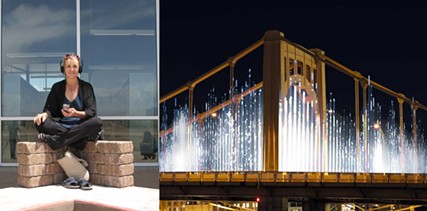
Tags: Andrea Polli , Hack the Grid , Carnegie Museum of Art , Bellefield Boiler , environmental art , Program Notes , Image
Wednesday, January 25, 2017
"My initial reaction was here we go again because there's been a narrative across our country that when black people call the police for help, they end up killed and it has happened many times," says Brandi Fisher, director of the Alliance for Police Accountability. "And sometimes or most times, it's because of that bias that some officers have who assume the black person is the criminal."
But there has been something different about this officer-involved shooting. Usually, Fisher struggles to find out information in the wake of a controversial police incident and can't get the police to return her calls. However, this time, the Pittsburgh Bureau of Police called her.
"I don't know how many cities can really say that when there's a police shooting, the police are reaching out to grassroots organizations that fight police brutality," says Fisher. "It was a testament to the relationship I think we have built and a testament to our work as well."
Officials are still sorting out the facts of the Jan.22 homicide. The two officers involved, whose names have not been released, are on paid administrative leave and the Allegheny County District Attorney's office is investigating.
But according to the bureau statement on the incident, "Officers were in the process of attempting to gain entry into the residence, a male inside of the home began firing shots in the direction of officers who were on the front porch. The officers returned fire and the 57-year-old homeowner was shot."
A suspect, 23-year-old Juan Brian Jetter-Clark, believed to be the burglar, was taken into police custody and charged with criminal trespass.
The Pittsburgh Citizens Police Review Board is waiting until any criminal investigation involving the incident is completed until they determine any possible action. But CPRB Executive Director Beth Pittinger says investigation into the incident hinges on what information was conveyed to the officers involved.
"You have to go back to the very beginning, which would be the call. What was conveyed to the 911 call taker? And then what did that call taker convey to the dispatcher and then what did the dispatcher convey to the police officers," says Pittinger. "You have to understand what they knew when they arrived. And then decide were their actions reasonable."
In a statement Acting Cheif Scott Schubert said:
"A horrible chain of events unfolded on Finley Street in Larimer this past Sunday. It's difficult to find the words to describe the amount of empathy that I have for both the family of Christopher Thompins and the two officers who were involved in the shooting. There are a lot of questions that we cannot immediately answer because we are currently reviewing the incident with the oversight of the Allegheny County District Attorney's Office. We have already reviewed the 911 call and video from the scene, and have scheduled interviews with the officers involved. We hope to offer details about the circumstances of the incident as soon as possible."
While Fisher might be encouraged by the bureau's response to the officer-involved shooting she says questions remain. Among them are whether the police officers announced themselves, was the homeowner already shooting when they arrived, was Thompkins shooting in the direction of the officers and ultimately, was he shooting at all.
"There's no doubt in our minds that this situation was not a malicious one. That doesn't mean there was no negligence," Fisher says. "We're still waiting to find out the facts to see what needs to be changed because this is a situation that should never happen.
"We are still concerned about this case because no one should ever call the police for help and end up killed by the police. We need to find out why that happened and how that happened."
And despite her more favorable view of the way the police have handled the incident, Fisher is disappointed by the media's response, especially a KDKA report detailing the homicide victim's criminal past.
"It seems totally irrelevant. That type of reporting just keeps the divide between the community and law enforcement," says Fisher. "All it does is anger people and it makes it appear as if the police are trying to discredit the victim, to sway people's focus off of the issue and to criminalize and demonize the person who was shot by police, even though it's the media reporting it."
Fisher has worked hard to improve community-police relations over the years, an effort that was strengthened under the leadership of former Chief Cameron McLay who left the city last year. Some worried progress made under McLay — a chief dedicated to improving the relationship between the police and the black community — would be lost.
Overwhelmingly that hasn't been the case according to Fisher. But she does worry about the department backsliding on some of the internal work Cheif McLay was doing.
"I was worried about the internal work on culture that he was working on not continuing and [worried] that there was not going to be a vocal and aggressive resistance to the [police union] and I'm still concerned about that," says Fisher.
Tags: police , homicide , Pittsburgh , Image
Pittsburgh-area projects are listed at 45 and 46 on the list and come with a $2.6 billion price-tag. But sorry to those North Hills residents, who voted for Trump in troves, you are not getting that light-rail line to Pittsburgh you have always wanted. In fact, the two Pittsburgh projects are more of the necessary, but boring variety.
Priority number 45 is a much-needed upgrade to the locks and dams on the Ohio River in Emsworth, Moon, and Beaver County. According to the report, these facilities are the “oldest and smallest lock chambers” on the Ohio River. And priority number 46, is also a lock and dam upgrade, this one on the Monongahela River in Charleroi. Not the sexiest of projects.
However, combing through the list shows Trump does have an inkling for supporting some pretty exciting infrastructure plans. A proposed high-speed rail line between Dallas and Houston is on the list at number 13. Also some green infrastructure plans make the list, including a wind farm in Wyoming and a storm water reduction plan in Cleveland.
And while Pittsburgh's plans are comparatively dull, both of the lock-and-dam projects would surely be a boon to the economies of these river towns (they could provide up to 2,600 jobs,according to the report). But even though Trump campaigned on providing $1 trillion in infrastructure spending, that doesn’t mean any of the projects are close to a reality.
Any large infrastructure bill would need to get U.S. Congressional approval before going through, and Senate Majority Leader Mitch McConnell (R-Kentucky) stated after Trump’selection victory that a big infrastructure plan was not a big priority to Congressional Republicans, who control both the House and Senate.
Regardless, Pittsburgh is in need of an infrastructure boost. According to a 2011 Transportation for America report, Pittsburgh has the highest percentage of structurally deficient bridges in the country at 30.4 percent. Oddly, number 6 on Trump's priority list is a project to address 15 of Philadelphia's structurally deficient bridges. Classic, Philly, always getting all the Pennsylvania attention.
Tags: Donald Trump , Pittsburgh , Charleroi Lock and Dam , Emsworth Lock and Dam , Image
Earlier today, Uber announced they were donating $10,000 to the local shelter to help offset these transportation costs for victims of domestic violence. In turn, the shelter will request rides for their clients using the Uber ride-hailing application.
"When you hear about Uber in Pittsburgh, you generally think of our self-driving cars and the efforts we make toward the future of transportation. But Uber's investment in Pittsburgh goes much deeper than that," said Shari Shapiro, senior public affairs manager for Uber Pennsylvania. "Affordable and reliable transportation is especially important for the Women's Center's clients. At this moment in their life they are under extraordinary stress, their worlds have been turned upside down and the last thing we want them to have to worry about is how to get to the shelter or how to get to the many appointments they need to put their lives back together."
Shapiro said Uber has developed similar partnerships with homeless shelters, but believes this is Uber's first partnership with a woman's shelter. Asked by Pittsburgh City Paper if Uber would pay the difference if the cost of the shelter's 2017 Uber rides exceeds the $10,000 donation, Shapiro said, "We'll have to jump off that bridge when we come to it."
The center serves more than 6,000 victims of domestic violence every year, more than 500 of whom include women and their children entering the shelter.
"We are so thankful that this partnership will be an incredibly easy and safe way to help the victims of domestic violence we serve," said Nicole Molinaro Karaczun, director of services for Women's Center and Shelter of Pittsburgh, "
The partnership between Uber and the shelter was spearheaded by Pittsburgh City Councilor Dan Gilman.
"As Pittsburgh moves to a new economy and brings in new economic partners, we have to work together to also realize the importance of corporate and social responsibilities and make sure we're reaching out to the people of our communities when they need it most," said Gilman.
Tags: domestic violence , transportation , Uber , women's shelter , Image


